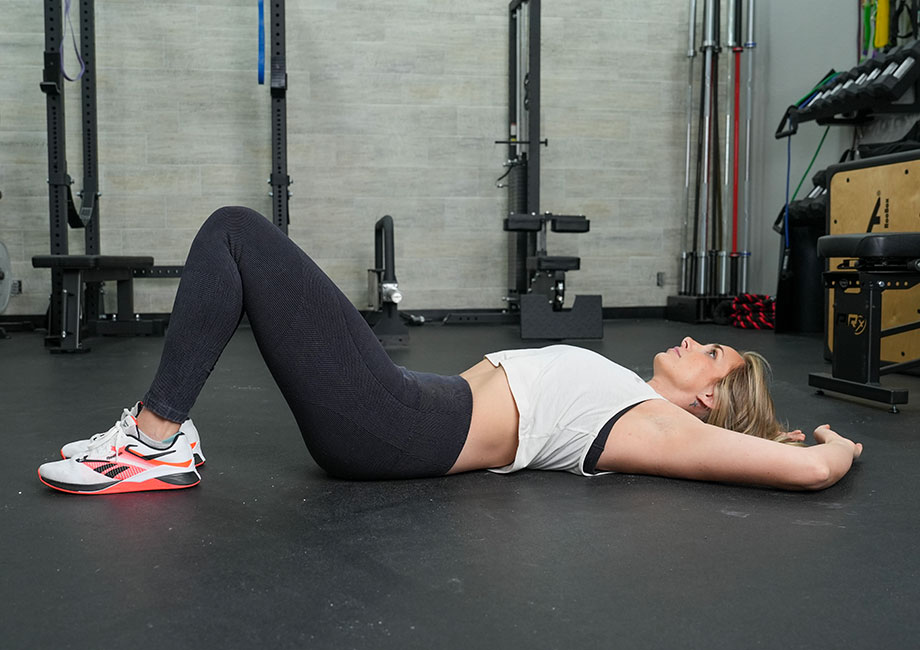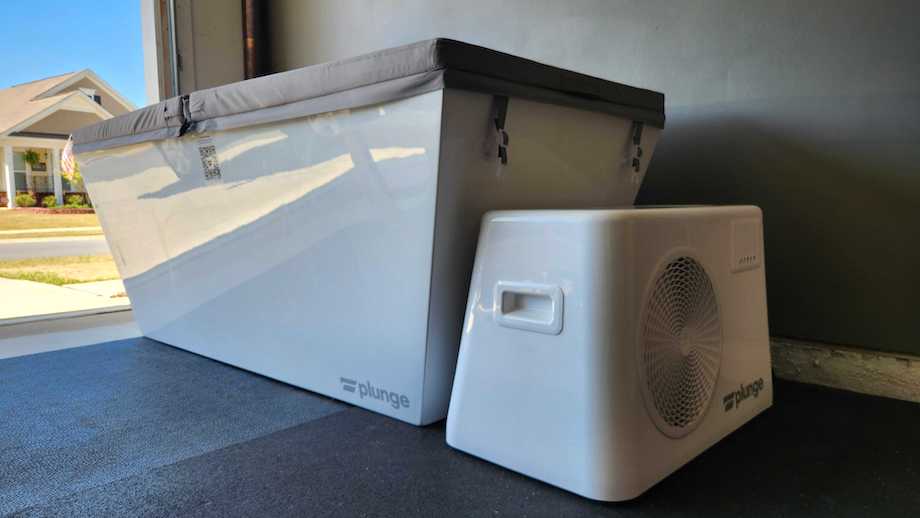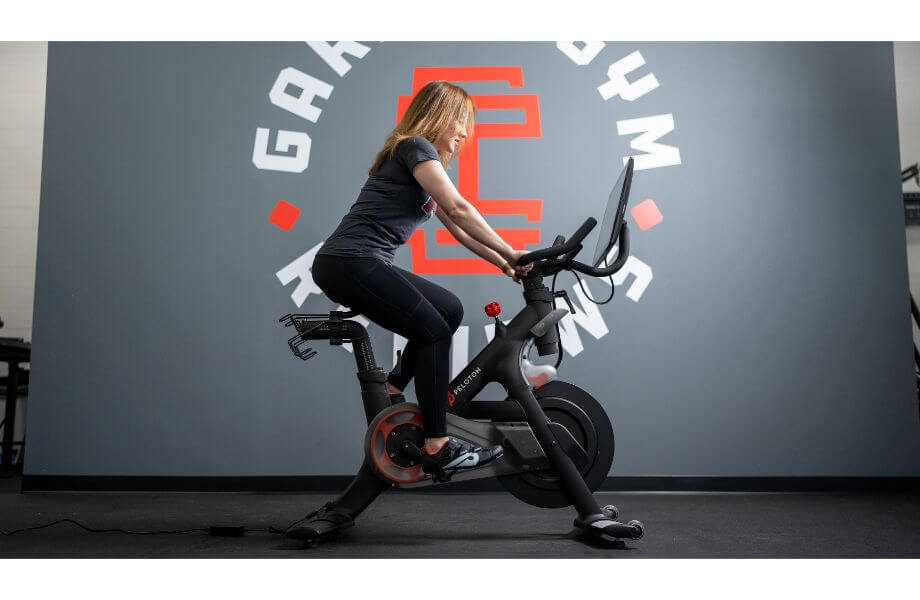The pelvic tilt exercise may seem unassuming, but Pilates practitioners know firsthand that this elementary movement offers plenty of upside. Simply lying down and tilting your pelvis helps build core strength and stability, promote proper spinal alignment, and enhance overall body awareness/wellness.
RELATED: Pilates Workout
GGR Senior Director of Fitness Content Kate Meier, NASM-CPT, USAW-L1, CF-L1, teaches us how to do a pelvic tilt exercise, giving us top trainer tips, common mistakes to avoid, pelvic tilt variations, and much more. Check it out below!
How to Do the Lying Pelvic Tilt Exercise
Muscles worked: Abdominal muscles,erector spinae, pelvic floor muscles, hip flexors, glutes
How to do it:
- Lie supine on the floor with your knees bent and feet planted.
- Breathe in, then exhale, engage your abs, and tilt your tailbone upward.
- Inhale again, letting your spine and pelvis return to the starting position.
- Repeat for reps or time.
RELATED: Best Exercise Mats
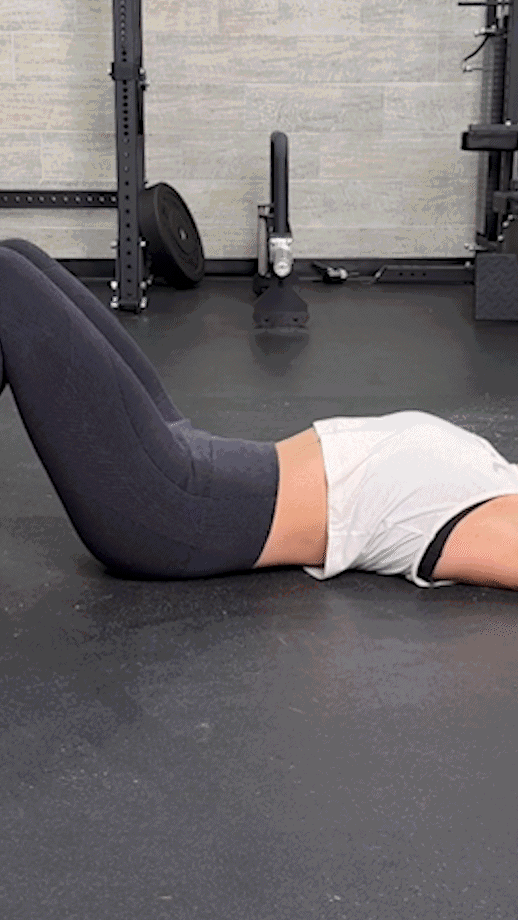
Trainer Tips for Form
The pelvic tilt seems super simple but can be deceiving. It’s easy to lose the plot on this one, so here are a few tips to help you pursue the perfect form.
Mind the Curve
There are many elements associated with the proper starting position for the pelvic tilt exercise, including:
- The back of your head should be touching the floor or mat
- Your neck and spine should stay in a neutral position
- Your arms should be extended alongside your torso
- Your knees should be bent
- Your feet should be firmly planted
But, what about your lower back?
A healthy lumbar spine naturally curves in an S-shape, so, in your starting position, your lower back would not be touching the floor unless you purposely force it to make contact.
RELATED: Lower Back Exercises
“You want to start with a space between your lower back and the mat,” says Kate Meier, NASM-CPT, USAW-L1, CF-L1. “As you perform the pelvic tilt, that space will close, and your lower back will touch down. You should feel a gentle stretch in your lower back at this point as well.”
Remember to Breathe
According to the International Journal of Sports Physical Therapy1, breathing normally during exercise is crucial for maintaining posture and spinal stability, safeguarding you from various injuries.
A recent study in Scientific Reports2 also found that breathwork, particularly the kind employed during yoga and Pilates practices, “may be effective for improving stress and mental health.”
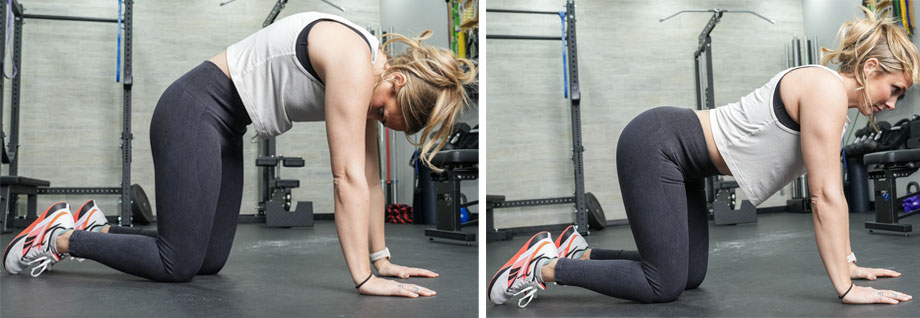
But, perhaps the most important reason to breathe during the pelvic tilt exercise is because, you know, you need oxygen to live, and you’ll probably pass out if you hold your breath too long.
“Breathing encourages proper biomechanics and core bracing, which is essential during the pelvic tilt exercise,” says Kate. “Syncing your breath with your movements is a great way to ensure you’re both moving efficiently and protecting yourself in the process.”
Keep Your Butt Down
Some folks may see the starting position and wrongfully assume that the pelvic tilt exercise is similar to the glute bridge. There are some similarities, but the pelvic tilt features a significantly smaller range of motion and much more core activation.
“A good way to know that you’re focusing on the right muscle groups is to keep your butt on the floor,” says Kate. “There should be no glute contraction during the pelvic tilt exercise.”
RELATED: Best Glute Machines
So, if you’re squeezing your gluteus maximus on each rep, reassess your form. If you’re having a hard time determining if you’re doing the pelvic tilt exercise correctly, consider working with a certified personal trainer (CPT), doctor of physical therapy (DPT), or other qualified fitness professional.
Benefits of The Pelvic Tilt Exercise
We know they’ll force you to do these if you show up at a Pilates class, but are there reasons you should incorporate this in your regular workout routine anyway? Absolutely!
Here are a few benefits associated with pelvic tilt exercise.
Helps Increase Core Strength and Stability
Anyone performing the pelvic tilt exercise—especially when done correctly—can attest to its effectiveness at engaging your core muscles.
RELATED: Best Ab Exercises
According to a 2016 study published in Physical Therapy Research3, the movement primarily engages deep intrinsic stabilizers like the multifidus, erector spinae, and transverse abdominis.
“Many core exercises target the superficial ‘six-pack muscle,’ the rectus abdominis, but it’s harder to isolate and strengthen the deep muscles like the multifidus and transverse abdominis,” says Kate. “The pelvic tilt exercise is useful for targeting and strengthening these harder to hit but equally important muscles.”
Helps Reduce or Prevent Back Pain
Performing the pelvic tilt exercise and other core strengthening exercises work wonders for building core strength and stability, but that’s not all.
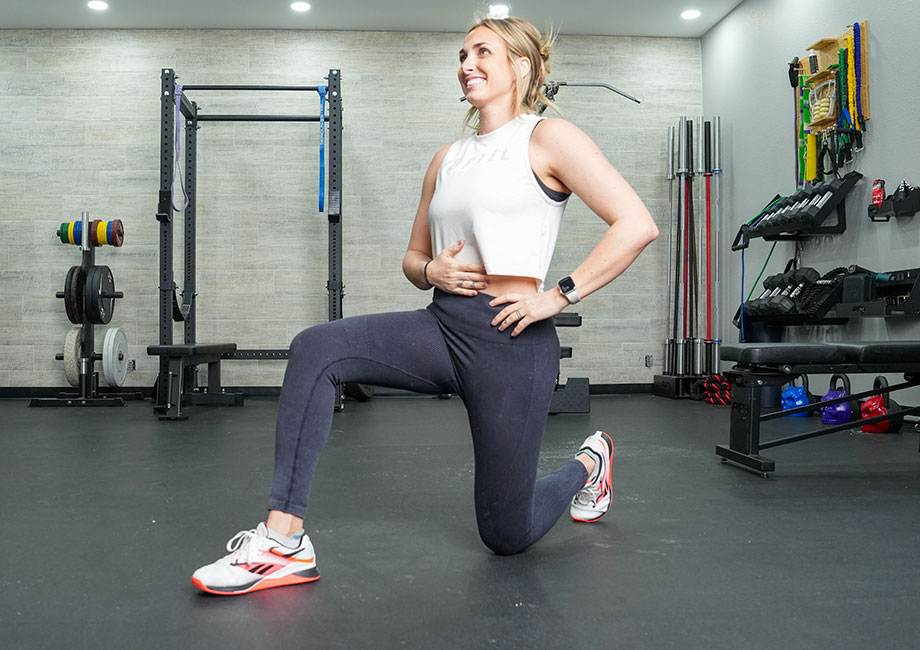
According to the International Journal of Sports Physical Therapy4, core stabilization exercises may be considered a viable method for treating non-specific low back pain. That’s fantastic news, since more than half a billion people worldwide5 suffer from lower back pain daily.
Given this information, a comprehensive core workout—containing exercises like the pelvic tilt—may offer pain relief for non-specific low back pain and sciatica.
RELATED: Thoracic Mobility Exercises
Helps Fix Anterior Pelvic Tilt, Posterior Pelvic Tilt, and/or Lumbar Lordosis
Poor posture does a number on your spine and, in some cases, could result in conditions such as anterior pelvic tilt, posterior pelvic tilt, and lumbar lordosis6.
Patients affected by the above conditions are categorized by having a pelvis that tilts too far in one direction. For anterior pelvic tilt, shear forces have pushed the pelvis forward,creating an extreme lower back arch called lumbar lordosis. With the posterior pelvic tilt, it is the opposite; the pelvis tilts backwards, causing an inward arch of the lower back.
Individuals with such conditions may not be aware, but they may experience low back pain or sciatica. Physical therapists, doctors, and chiropractors may recommend performing correction exercises, such as the pelvic tilt exercise, to loosen tight muscles, strengthen surrounding muscle groups, and promote improved posture.
According to the Journal of Physical Therapy Science7, exercise is crucial for relieving back pain associated with these conditions and for restoring proper pelvic angle, lumbar range of motion, and overall functionality.
If you suspect you have a medical condition that causes you pain, consult your doctor, a DPT, or other qualified healthcare professional immediately. They will provide proper medical advice and a treatment plan tailor-made for you.
Helps Improve Sexual Function
We know that the pelvic tilt exercise strengthens the pelvic floor, which is beneficial for a variety of reasons. According to the International Urogynecology Journal8, a stronger pelvic floor may equate to higher sexual activity and function in women.
The 2015 study determined that “a strong pelvic floor is associated with higher rates of sexual activity…[and] sexual function,” as participants reported increased libido, heightened arousal, improved performance, and greater pleasure from sex.
Common Pelvic Tilt Mistakes
There are many benefits associated with the pelvic tilt exercise, but you have to do it correctly to reap the rewards. Here are the most common mistakes to avoid while doing supine pelvic tilts.
Pushing Your Abs Outward
“When we brace our core muscles, we have a tendency to push them outward, but that’s the opposite of what you want to do during the pelvic tilt exercise,” says Kate Meier, NASM-CPT, USAW-L1, CF-L1. “Instead, draw them inward and engage them from that specific position.”
That’s where the ever-frustrating cue of “pulling your belly button to your spine” comes from because, while it baffles beginners in Pilates classes everywhere, it’s exactly what you should feel like you’re doing.
RELATED: Functional Core Exercises
Another way to visualize and conceptualize is by imagining a bowl of water sitting on your pelvis. As you draw it inward, the imaginary bowl tips and spills water into your belly button, indicating that you’re spot on with your movement.
Too Much Tension
The pelvic tilt exercise is about getting a powerful contraction of the deep core stabilizers, but that’s the only place you should hold any tension.
Your neck, shoulders, quads, hip flexors, and glutes should be comparatively relaxed. Holding tension in these areas reduces the impact of the exercise on the target muscles and, more importantly, may cause or contribute to injury. Ouch!
Pelvic Tilt Variations
Once you’ve mastered the standard supine pelvic tilt exercise, you can try some of these other convenient variations for performing your pelvic tilts in various positions.
Standing Pelvic Tilt
Why do it: “Standing pelvic tilts are perfect for pregnant women or people who have a hard time lying flat on their back due to medical conditions,” says Kate Meier, NASM-CPT, USAW-L1, CF-L1. “They’re also great if you’re at the office trying to sneak in something to stave off the negative effects of sitting at your desk all day.”
How to do it:
- Lean against a wall (or stand in place) with your knees slightly bent.
- Breathe in, then exhale as you push your pelvis forward and up. Your lower back should press into the wall behind you as you move.
- Hold briefly, then return to the starting position.
- Repeat for the desired number of repetitions or duration.
RELATED: Office Workout – 16 Trainer-Approved Desk-Friendly Exercises
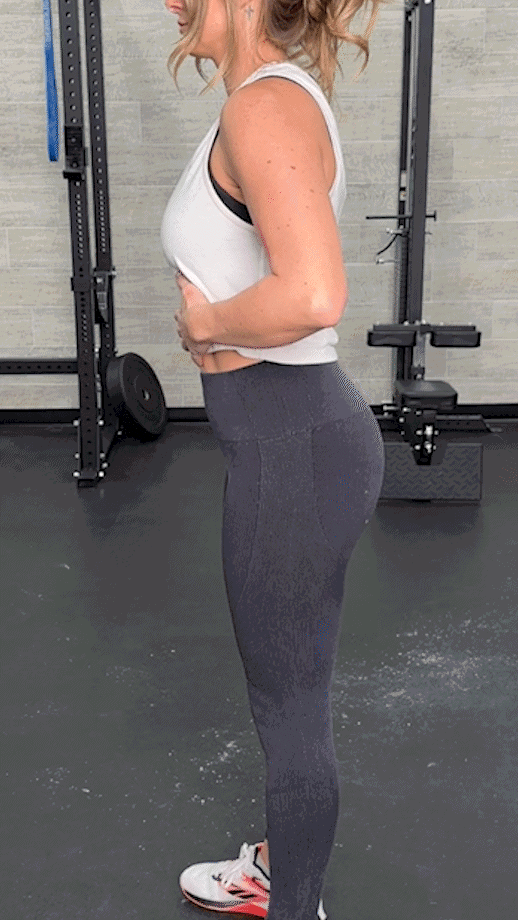
Kneeling Pelvic Tilt
Why do it: The kneeling pelvic tilt is similar to the “cat” phase of the cat-camel stretch, known to lengthen and strengthen your core muscles. This is a good movement for warm-ups, cool down exercises, and general core stability.
How to do it:
- Get into the quadruped position (“on all fours”) with your wrists vertically stacked beneath your shoulders and your hips directly above your knees.
- Breath in, then exhale as you pull your abs inward and round your back.
- Hold briefly, then return to the starting position.
- Repeat for reps or time.
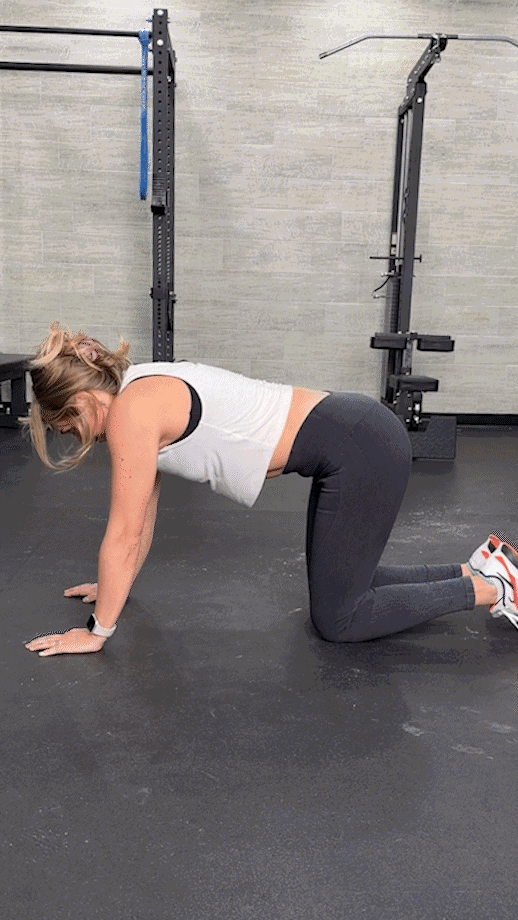
Half-Kneeling Pelvic Tilt
Why do it: Performing pelvic tilts from a half-kneeling position is more challenging than other variations, but you’ll get increased muscle activation from rising (literally) to the challenge of maintaining your stability in this position.
How to do it:
- Assume a half-kneeling position—one foot forward with your knee bent and your opposite knee planted on the mat. Keep your chest tall, hands on your hips, and shoulders relaxed.
- Breathe in, then exhale and lift your pelvis toward your belly button, drawing the tailbone toward the floor.
- Hold the position briefly, then return to the starting position.
- Repeat for reps or time.
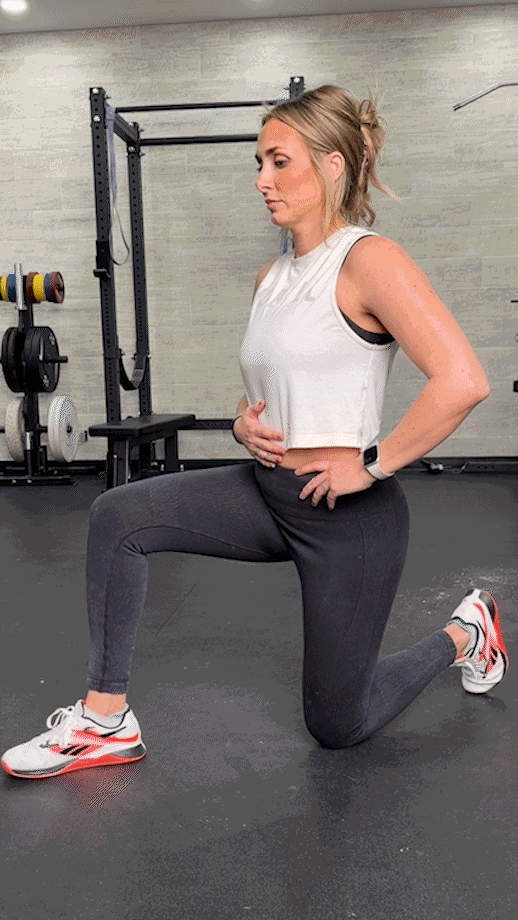
Precautions Before Trying The Pelvic Tilt Exercise
The supine pelvic tilt exercise is generally safe for most individuals, but certain individuals may be medically contraindicated (excluded due to medical reasons) from doing them. Those individuals include, but are not limited to:
- Pregnant women
- Those who cannot lie flat on their back
- Those recovering from a recent surgery
If you’re unsure if you should perform pelvic tilts, consult your doctor before adding them to your regular workout routine.
Pelvic Tilt: FAQs
What is pelvic tilt exercise good for?
The pelvic tilt exercise is great for general core strengthening, but also may relieve lower back pain, correct conditions caused by poor posture, and improve sexual health and function.
Although the supine pelvic tilt exercise is not recommended for pregnant women due to the dangers of lying on your back during pregnancy, standing variations are helpful during pregnancy and postpartum for strengthening the pelvic floor muscles. Ask your OB/GYN if the pelvic tilt exercise is right for you!
How to do pelvic tilt correctly?
“The pelvic tilt exercise involves tilting the pelvis and engaging your deep core muscles,” says GGR Senior Director of Fitness Content Kate Meier, NASM-CPT, USAW-L1, CF-L1. “It’s confusing at first, but working with a CPT or DPT may improve your chances of getting the form down pat.”
You can also follow our expert cues like paying attention to the curve of your lower back, maintaining your breath support, and keeping your butt on the floor.
What muscles do you strengthen to fix pelvic tilt?
The muscles targeted and strengthened by the pelvic tilt exercise are primarily the abdominal and pelvic floor muscles, and you may also receive some activation in the hip flexors, glutes, and hamstrings.
RELATED: Psoas Muscle Exercises
How long should you do a pelvic tilt for?
Fitness enthusiasts may mistakenly treat the pelvic tilt exercise like a plank variation and try setting a PR for longest hold. As it turns out, there’s no need for that; holding between 5 and 10 seconds at a time is often sufficient for getting the stimulus you’re seeking.
References
1. Bradley H, Esformes J. Breathing pattern disorders and functional movement. Int J Sports Phys Ther. 2014;9(1):28-39.
2. Fincham GW, Strauss C, Montero-Marin J, Cavanagh K. Effect of breathwork on stress and mental health: A meta-analysis of randomised-controlled trials. Sci Rep. 2023;13(1):432. Published 2023 Jan 9. doi:10.1038/s41598-022-27247-y
3. Takaki S Ms Pt, Kaneoka K PhD Md, Okubo Y PhD Pt, et al. Analysis of muscle activity during active pelvic tilting in sagittal plane. Phys Ther Res. 2016;19(1):50-57. Published 2016 Nov 29. doi:10.1298/ptr.e9900
4. Smrcina Z, Woelfel S, Burcal C. A Systematic Review of the Effectiveness of Core Stability Exercises in Patients with Non-Specific Low Back Pain. Int J Sports Phys Ther. 2022;17(5):766-774. Published 2022 Aug 1. doi:10.26603/001c.37251
5. Low Back Pain. World Health Organization. Accessed January 31, 2024. https://www.who.int/news-room/fact-sheets/detail/low-back-pain.
6. Been E, Kalichman L. Lumbar lordosis. Spine J. 2014 Jan;14(1):87-97. doi: 10.1016/j.spinee.2013.07.464. Epub 2013 Oct 2. PMID: 24095099.
7. Yoo WG. Effect of Individual Strengthening Exercises for Anterior Pelvic Tilt Muscles on Back Pain, Pelvic Angle, and Lumbar ROMs of a LBP Patient with Flat Back. J Phys Ther Sci. 2013;25(10):1357-1358. doi:10.1589/jpts.25.13578.
8. Kanter G, Rogers RG, Pauls RN, Kammerer-Doak D, Thakar R. A strong pelvic floor is associated with higher rates of sexual activity in women with pelvic floor disorders. Int Urogynecol J. 2015;26(7):991-996. doi:10.1007/s00192-014-2583-7


